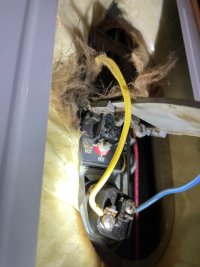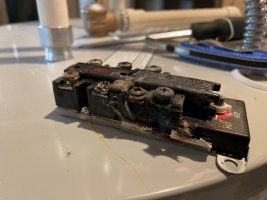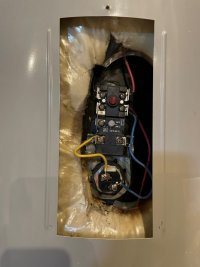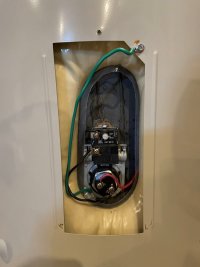Eflickinger
New Member
Hello,
Recently we had an issue with our water heater. It started with an electrical burn smell at which point I pulled the covers to find that the upper thermostat had short circuited (see pictures). A plumber came out and replaced the upper / lower elements and both thermostats. We agreed to leave the covers off for a bit to kind of monitor the situation given the severity of the initial trouble. However, he wasn't very interested in understanding why the thermostat was burned out the way it was which has me kind of concerned. After a week of diligent checking I decided to button everything up with the panels / batting / insulation / etc. and all was good. However, after about another week or so I decided to pull the panels again and the insulation is wet. Not soaked, but clearly wet. This was true for the initial trouble as well, but there's no clear source of the leak (maybe some rusty water trails on the bottom element area?). The walls of the tank had a fair amount of condensation? The unit is roughly 6 years old so i'm not quite ready to replace it, but i'm also concerned about our safety. Can I just put the panels back on without the insulation for the time being? Effectively breaking the link between the water and the thermostat. Thanks for any opinions...
The first two photos are before (burned out obviously) and the last two are after replacement with some tank surrounding area for context.
Recently we had an issue with our water heater. It started with an electrical burn smell at which point I pulled the covers to find that the upper thermostat had short circuited (see pictures). A plumber came out and replaced the upper / lower elements and both thermostats. We agreed to leave the covers off for a bit to kind of monitor the situation given the severity of the initial trouble. However, he wasn't very interested in understanding why the thermostat was burned out the way it was which has me kind of concerned. After a week of diligent checking I decided to button everything up with the panels / batting / insulation / etc. and all was good. However, after about another week or so I decided to pull the panels again and the insulation is wet. Not soaked, but clearly wet. This was true for the initial trouble as well, but there's no clear source of the leak (maybe some rusty water trails on the bottom element area?). The walls of the tank had a fair amount of condensation? The unit is roughly 6 years old so i'm not quite ready to replace it, but i'm also concerned about our safety. Can I just put the panels back on without the insulation for the time being? Effectively breaking the link between the water and the thermostat. Thanks for any opinions...
The first two photos are before (burned out obviously) and the last two are after replacement with some tank surrounding area for context.




